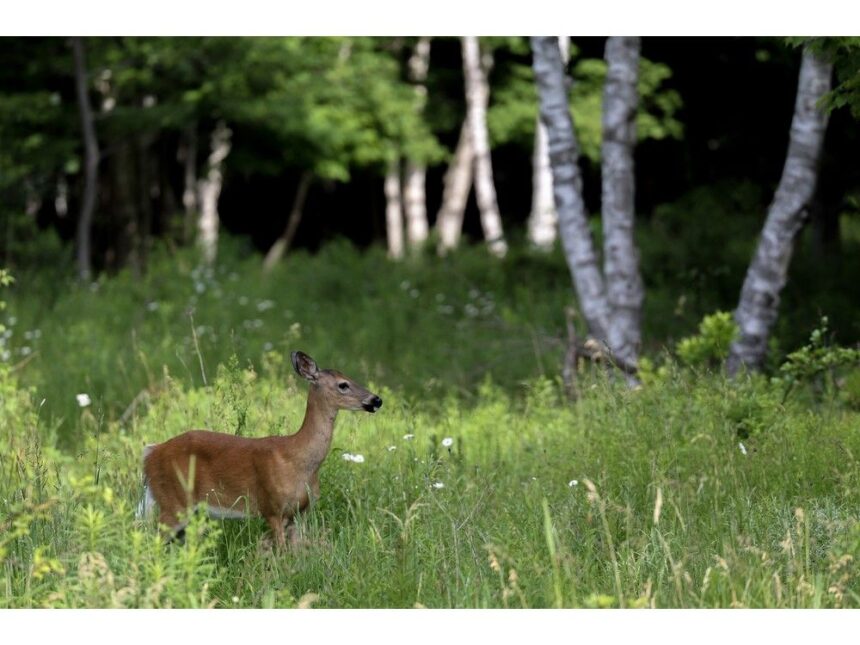Published Aug 15, 2025Last updated 1 hour ago5 minute readA deer grazes in south Dartmouth on June 24, 2025. Photo by Tim Krochak /The Chronicle HeraldArticle contentIf you were city born, as I was, the first time you saw a deer in the flesh may have been in an enclosure, in my case at the Shubenacadie Provincial Wildlife Park. THIS CONTENT IS RESERVED FOR SUBSCRIBERS ONLY.Subscribe now to access this story and more:Unlimited access to the website and appExclusive access to premium content, newsletters and podcastsFull access to the e-Edition app, an electronic replica of the print edition that you can share, download and comment onEnjoy insights and behind-the-scenes analysis from our award-winning journalistsSupport local journalists and the next generation of journalistsSUBSCRIBE TO UNLOCK MORE ARTICLES.Subscribe or sign in to your account to continue your reading experience.Unlimited access to the website and appExclusive access to premium content, newsletters and podcastsFull access to the e-Edition app, an electronic replica of the print edition that you can share, download and comment onEnjoy insights and behind-the-scenes analysis from our award-winning journalistsSupport local journalists and the next generation of journalistsRegister to unlock more articles.Create an account or sign in to continue your reading experience.Access additional stories every monthShare your thoughts and join the conversation in our commenting communityGet email updates from your favourite authorsSign In or Create an AccountorArticle contentNow, I see them up close all the time, sometimes just a couple of metres away, bounding across the road, standing in the vegetable garden, chomping on greenery. Article contentArticle contentSomething else has changed, too. Article contentTime was when I oohed and aahed at the sight of one. It’s the same graceful, doe-eyed, white-spotted animal. But my romance with Bambi has cooled, as it has for many two-legged Nova Scotians. Article contentArticle contentDeer have a massive public relations problem in a province where they suddenly seem to be everywhere. Article contentInstead of cute, cuddly wildlife that epitomize gentleness, innocence and beauty, they are increasingly viewed as over-abundant pests that eat our rhododendrons and dine on our carrots. Article contentEven worse, their skins and fur can teem with poppy-sized black-legged ticks, the primary transmitters in this province of Lyme disease, which, in humans can cause symptoms ranging from a rash and flu-like illness to serious joint, heart and nervous system complications if left untreated. Article contentAre deer on the rise in Nova Scotia? Article contentHistorically, yes. Article contentAccording to information on Nova Scotia’s Department of Natural Resources and Renewables website, white-tailed deer arrived in the province in the late 1800s. Since then their population has swung significantly. Article contentArticle contentThough definitive figures are hard to find, populations have been rising in parts of the province in recent years. What is equally undeniable is that more deer are finding their way into towns, villages and even suburbs of Halifax. Article content Deer graze in Shannon Park in Dartmouth on Nov. 4, 2024. Photo by Tim Krochak /THE CHRONICLE HERALDArticle contentArticle contentWhy are their numbers rising ? Article contentSeveral factors are behind the rise in white-tailed deer, the only species naturally found in Nova Scotia. Article contentDecades ago the province introduced a “buck only” law that protected breeding females from hunting and allowed more younger fawns to survive. But the prohibition’s lingering impacts continue to contribute to the high deer numbers seen today. Article contentSome argue that coyotes and other predators have been taking fewer deer in Nova Scotia — a view that doesn’t seem particularly credible. More legit is the position that mild and shorter winters, like recent ones in this province, allow more does and fawns to survive the hard months, bolstering their population. Article contentHumans, in a way, also have themselves to blame for the population surge and the fact that deer have become more of a factor in their lives.Article contentHuman sprawl creates edge habitat, the place where forests meet open areas like fields or suburbs. Deer thrive in those areas, where food tends to be plentiful. Experts calculate that deer populations in edge habitats can be five to 10 times higher than in natural environments. Article contentPeople like to feed them, too. Whether that happens intentionally — apples or other fruits or vegetables left out in the yard — or unintentionally via their gardens, those easily accessible food sources are boosting deer survival rates and luring them closer to humans. Article content A young whitetail peers from cover, seen off a path in Eastern Passage in 2023. Photo by Tim Krochak /The Chronicle HeraldArticle contentAre more deer a bad thing? Article contentThey may look adorable, but deer are ravenous eaters, gorging themselves on up to four kilograms of vegetation a day, depending upon body weight. Article contentArticle contentThat’s no big deal in the spring and early summer, when deer mostly graze on green plants and grasses. The problems begin about this time of year and run right through the fall, when natural forage sources like grasses get tougher and leafy plants dry out. Then farm crops and even ornamental plants in gardens look enticing. Article contentThat’s a problem if you are a farmer, and a nuisance for homeowners. Article content“They’re very pretty but they eat everything in the garden,” a resident of Halifax’s Woodlawn community said recently on Reddit. “Even things that are supposedly deer proof.” Article contentAre they dangerous? Article contentNot directly. But they bound out onto roads, and bad things can happen when a car hits a deer or swerves to avoid one. Article contentIn early 2024, a 42-year-old woman hit a deer with her Honda CR-V near New Glasgow. Shortly afterward, her car was rear-ended by a transport truck. She was airlifted to Halifax but died from her injuries. Article contentArticle contentWhat about Lyme disease? Article contentBlack-legged ticks are the main transmitter of Lyme disease in Nova Scotia, which has the highest tick-to-person ratio of any Canadian province. Consequently, it also has the highest incidence of Lyme disease in the country. Article contentBlack-legged ticks are found in high grass, low vegetation and shrubs. During their adult stage they often feed on white-tailed deer, which is why the ticks are often known euphemistically as deer ticks. Article contentLyme disease, which 76 per cent of those ticks in Nova Scotia carry, is a nasty ailment. A bite from a deer tick is capable of leaving a person with everything from severe arthritis and joint pain to memory issues and an inability to concentrate, along with other brutal symptoms. Article contentArticle content What can keep the numbers down? Article contentThe situation is distressing enough for some municipalities to take desperate measures. Truro has resorted to targeted crossbow hunts within the town limits to cull the deer herd. Article contentYarmouth is counting deer droppings to calculate the deer population and reportedly plans to use to plan a safe, community-supported deer cull. Article contentHalifax regional council staff have been asked to prepare a report on the possibility of increasing fines for feeding wildlife, particularly deer. Article contentThe province, meanwhile, is tweaking its hunting rules to target areas with the worst deer populations, Article contentHow can I keep deer away from my plants? Article contentThe first step, according to the Halifax Seed Company, is to determine that deer are the actual culprit ravaging your garden. Article content“Look for jagged markings on the leaves and heads,” the Halifax gardening store’s website says. “Deer don’t have strong teeth and need to pull plants apart to eat them.” Article contentIf you decide to build a fence around your garden, ensure it’s at least eight feet high so deer can’t jump over it. Article contentA better approach might be planting plants that deer find unappealing — like lavender, poppies and black-eyed Susans — around the edge of the garden. Article contentOr, since deer steer clear of strong scents, use a repellent, either bought off the shelf or homemade, to make them avoid your vegetable patch.Article content
John DeMont: How did deer go from doe-eyed Bambis to ravenous, plague-carrying pests?











